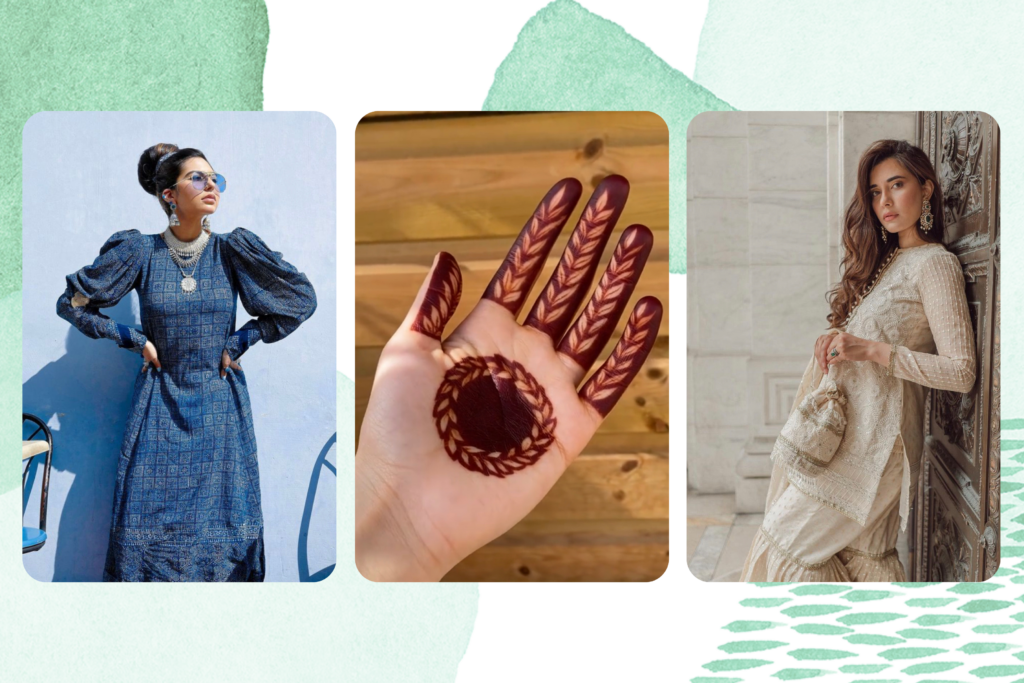
Photos: Instagram/Marjhan Kausar, Samendi, Mehrunissa
After spending the last two Eids in complete lockdown, behind computer screens, we are hoping Eid 2021 will be different — promising a slight return to normalcy, if not complete. Because, fortunately, we can now see close family members and mingle in small groups, at least here in the U.S. (of course, with the necessary standard operating procedures [SOPs] in place). That’s all the more reason to ditch your much-loved loungewear and dress up! It is, after all, what some Twitter users call “The Muslim Met Gala.”
Of course, style is personal; there really is no right or wrong way to looking or feeling your best. It’s easy to feel overwhelmed by desi fashion pages flooding our Insta-feed with stylish Eid look-books. So let me help you decode what you’re better off ignoring and what you should be wearing instead. Consider this my Eidi to you!
[Read Related: Eid Glam: An Easy and Flirty Makeup Look to Rock to Your Festive Celebrations]
Puffy Sleeves
All that oomph and all that poof…puffy sleeves were all the rage in 2020, that almost all notable designers had at least one solid outfit featuring puffed-up sleeves. But come 2021, it’s time to try straighter, fitted sleeves for a more defined look! Here is New York City blogger Mehrunissa showcasing just how sleek structured sleeves look and why you ought to try them out this Eid.
View this post on Instagram
Big Bags
Let’s be real, no Eid is complete without some Eidi! I am already thinking in dollars…and all that moolah requires a handy handbag, one that also goes perfectly well with your outfit. Now, you may be making some bucks, but for Eid 2021 all you need is a micro purse to carry them. Micro-purses go with any type of outfit — be it a three-piece suit, lehenga choli or anarkali. They are the perfect additions to a fashionable look. So ditch the totes and go for the mini because great things come in small packages. Check out the super-chic Rohma Siddiqui flaunting a mini purse with her Eid-inspired look!
View this post on Instagram
Solid Separates
Solid separates make for functional yet elegant additions to our wardrobes, and so, many designers chose to include plain, solid raw silk separates in their collections last Eid. This time around, I suggest you play with some prints and embroidery when it comes to the fabric. You can go print-on-print or borrow your mom’s heavy dupatta and pair it up with your plain white shalwar kameez. Or, just spruce things up with a fully-embroidered outfit like NYC fashionista, Sofia.
View this post on Instagram
One-Way Street to the East
We just love it when South Asian women pair their sarees with a blazer and a belt. Yet, we barely see the mix and match happen on Eid. I don’t blame ya, I love my ethereal ghararas with a pair of classic juttis! But instead of sticking to the norm, why not bring out some Western accessories to go with our outfits for Eid 2021? What’s a better way to define our style than by being exactly who we are: diverse! Take notes from Marjhan Kausar showing us how it’s done.
View this post on Instagram
Going for that Lawn Outfit
Ah, lawn season…we are all guilty of indulging in the mandatory lawn shopping. And, why not? They are usually the most comfortable and equally beautiful pieces that we can pair up with any kind of jewelry and call it a day. But it’s become a bit run-of-the-mill and chances are you’ll meet at least one other person wearing the exact same outfit as you. So tune into your individuality and go for a unique kaftan, draped dupatta or a bespoke stitched saree! But if you still prefer to wear lawn, there are ways you can mix it up and stand out. Here’s a tip: try tailoring your lawn suit, as a gharara, with a kiran dupatta like the elegant Rameesha.
View this post on Instagram
Bold and Blingy
This one’s a hard sell because who wouldn’t want to go all out after the past year and all the festivities locked up inside, away from family and friends? But simplicity is key. It is important to balance out your entire look and either keep your makeup or your jewelery/accessories minimal. Personally, I am planning on a simple, blushed look with a pair of gorgeous statement earrings, but you do you, whatever makes you happy! Looking to be inspired? Take a cue from style queen Mariyam Ishtiaq.
View this post on Instagram
Hand-Full of Henna
What’s Eid without Chaand Raat? And, what’s Chaand Raat without a mehndi session? It is undoubtedly my favorite part of Eid prep. And I’ll be honest, I am very fond of mehndi and tend to go a little extra with it. However, recently I’ve come across a range of simple, minimal henna designs, as opposed to overcrowded bridal ones on my Instagram feed and they are definitely worth a try. They are also more convenient for those of us who aren’t experts and/or want to go for a simpler look due to Covid restrictions. Here is a basic design you might want to screenshot!
View this post on Instagram
If you’re waiting till the last minute to sort out your Eid 2021 look but find yourself confused, these tips are sure to come in handy to help you look right on point. Eid Mubarak, peeps!




